 Loading... Please wait...
Loading... Please wait...Categories
- Books
- Judaica
- Jewish Holidays
- Judaica Art
- Judaica Bags
- Judaica Blessing
- Judaica Dancers
- Judaica Metal Stands
- Judaica Paper Mache
- Judaica Pomegranates
- Judaica Trivet
- Judaica Wall Hanging
- Salt & Pepper Shakers
- Judaica Flowers
- Judaica Hearts
- Judaica Jazz
- Judaica Heads
- Oil Shofars
- Judaica Bicycle Riders
- Judaica Cows
- Judaica Brooches
- Judaica Butterflies
- Judaica Birds
- Judaica Bowls
- Brooches
- Judaica Key Rings
- Judaica Jewelry
- Judaica Artists
- Home
- Judaica
- Shofar For Sale
- Kudu Shofar
Kudu Shofar
Kudu Shofar is made of Kudu antelope horn from Africa. The horns are harvested after the natural annual fall of the animal, and then polished and refined. They are available in styles that are dull, silver or varnished with various designs representing Jerusalem, David's star, and other Jewish symbols.
Traditionally, Kudu shofar is blown in the synagogue at special moments. In some occasions the kudu shofar is blown together with wearing both a tallit and a tefillin. Such items, such as the tefillin for sale, varry in prices, colors, sizes etc. For Rosh Hashanah ("Jewish leader of the year"), a holy day celebrating the creation of the world, he blossomed to recognize the importance and purpose of creation. Blows the shofar is considered a mitzvah - that is to say a commandment of God. At the end of Yom Kippur, the kudu shofar is blown to signal the end of the fast day. In ancient times, the sound of the Kudu shofar would be welcome in the Jubilee Year, announcing that all slaves were free to go. In modern times, it means that our souls are now free from sin.
Shofar Shape depends primarily on the animal that comes and varies considerably in size. However, all shofars have a curve or curve at them.
The Small measure of Kudu shofar is 20 to 40 centimeters and typically have a small curve for them. These Shofars usually come from a Kudu antelope and are used by Ashkenazi and Sephardic communities. However, there are also trumpets that are much larger, measuring between 45 and 50 centimeters. Moroccan shofars usually have a small curve and are very small, usually between 20 and 30 cm.
Larger shofars usually 60 centimeters or more. These shofars come from a Kudu and are used by the Jewish community and have two significant curves for them.
Kudu Shofar and other Judaica for sale products are available at Judaicamore.com.

 Our newsletter
Our newsletter